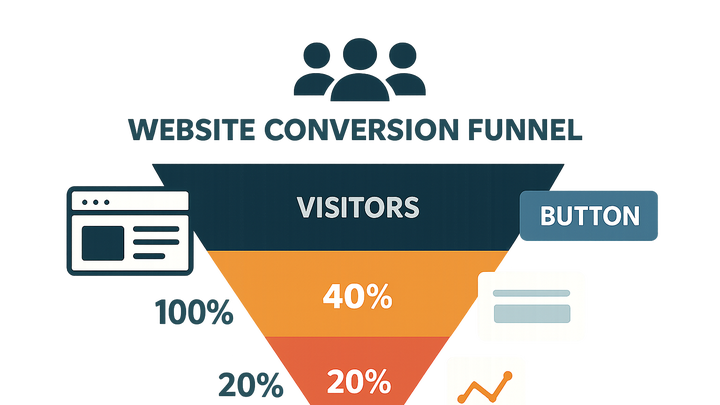Published on 2025-06-29T19:05:39Z
What is Conversion Rate? Definition & Examples
Conversion Rate measures the percentage of website visitors who complete a desired action, such as filling out a form, making a purchase, or subscribing to a newsletter.
It is a cornerstone metric in Conversion Rate Optimization (CRO), User Experience (UX) design, and SEO because it directly reflects how effectively a site engages and persuades its audience.
A high conversion rate indicates that your landing pages, messaging, and user journey resonate well with visitors, turning them into leads or customers.
Tools like Prevue.me can provide actionable critiques on CRO, lead generation, SEO, UX, and accessibility to help elevate your conversion rates.
By continuously monitoring and improving conversion rate, businesses can maximize ROI, enhance user satisfaction, and stay ahead in competitive digital landscapes.
Conversion rate
The percentage of website visitors who complete a desired action, reflecting the effectiveness of CRO, UX, and SEO strategies.
Why Conversion Rate Matters
Conversion Rate is a direct indicator of how well your website persuades visitors to take desired actions. It ties together efforts in CRO, UX, and SEO by measuring the end result of optimized experiences and targeted traffic. By focusing on conversion rate, businesses can assess the real-world impact of design changes, content strategies, and marketing campaigns. Improving this metric leads to higher revenue without necessarily increasing traffic, making it a cost-effective growth lever. Regularly tracking conversion rate also helps identify when changes negatively affect performance, enabling swift corrective actions.
-
Measure of effectiveness
A high conversion rate shows that your site’s messaging, layout, and calls-to-action resonate with your audience.
-
Cost efficiency
Increasing conversion rate maximizes returns on existing traffic, reducing the need for higher ad spend.
-
Performance benchmark
Conversion rate provides a clear benchmark to compare landing pages, campaigns, and traffic sources.
How to Calculate Conversion Rate
Understanding the formula for conversion rate is essential for accurate measurement. It’s a simple calculation that turns raw data into actionable insights. While most tools automate this computation, knowing how to calculate it manually helps validate analytics reports and supports custom analyses. Even subtle differences in defining what constitutes a “conversion” can significantly affect reported rates, so clarity is crucial.
-
Conversion rate formula
Conversion Rate = (Number of Conversions ÷ Total Visitors) × 100
- Example calculation:
If a landing page gets 2,000 visits and 100 form submissions, the conversion rate is (100 ÷ 2000) × 100 = 5%.
- Example calculation:
-
Defining conversions
Conversions can include purchases, sign-ups, downloads, or any event aligned with business goals.
Key Factors Influencing Conversion Rate
Various elements on your website affect how visitors interact and whether they convert. Optimizing these factors holistically is the essence of CRO. Small tweaks in copy, design, or functionality can have outsized impacts on conversion rates. It’s important to test changes systematically to understand what truly moves the needle.
-
Landing page design
Clean layouts, compelling headlines, and clear visual hierarchy guide visitors toward conversion.
-
User experience (ux)
Intuitive navigation, quick load times, and mobile responsiveness ensure visitors don’t abandon before converting.
-
Call-to-action (cta)
Strong, action-oriented CTAs with contrasting colors and persuasive copy drive clicks and submissions.
-
Trust and credibility
Elements like testimonials, security badges, and privacy notices reduce friction and build confidence.
Improving Conversion Rate with Prevue.me
prevue.me is a SaaS tool that delivers actionable critiques across CRO, lead generation, SEO, UX, and accessibility. It analyzes your website against best practices and pinpoints opportunities for improvement. By integrating prevue.me’s recommendations, teams can prioritize changes that yield the highest ROI and maintain a user-centric focus. Its comprehensive reports help streamline A/B testing roadmaps and accelerate optimization cycles.
-
Cro insights
Receive targeted recommendations on form fields, button placements, and funnel bottlenecks to boost conversions.
-
Seo feedback
Optimize meta tags, headings, and content structure to attract high-intent traffic that converts.
-
Ux and accessibility critiques
Identify navigation hurdles, readability issues, and accessibility barriers to enhance user satisfaction.
-
Lead generation optimization
Improve lead magnets, signup flows, and trust signals to capture more high-quality leads.
Common Conversion Rate Pitfalls
Avoiding typical mistakes can help sustain and improve conversion rates. Often, minor oversights in design or messaging can lead to significant losses. Regular audits and user testing catch issues before they become entrenched. Combining quantitative metrics with qualitative feedback ensures a balanced optimization strategy.
-
Complex forms
Too many fields deter users; streamline forms to essentials to improve submissions.
-
Unclear value proposition
If visitors don’t immediately understand benefits, they’re unlikely to convert.
-
Slow load times
Performance issues frustrate users and increase bounce rates before any conversion opportunity.
-
Lack of social proof
Without testimonials or reviews, visitors may lack trust to complete transactions.
